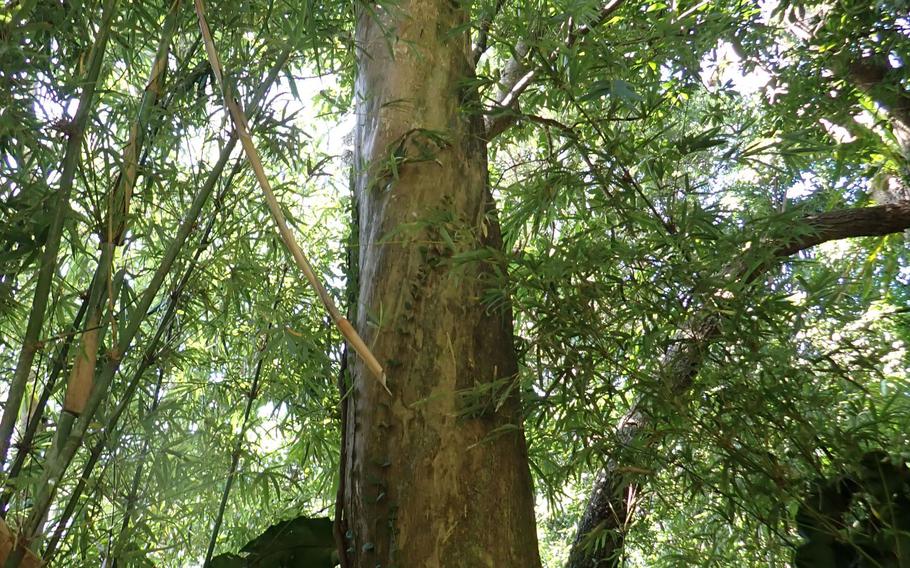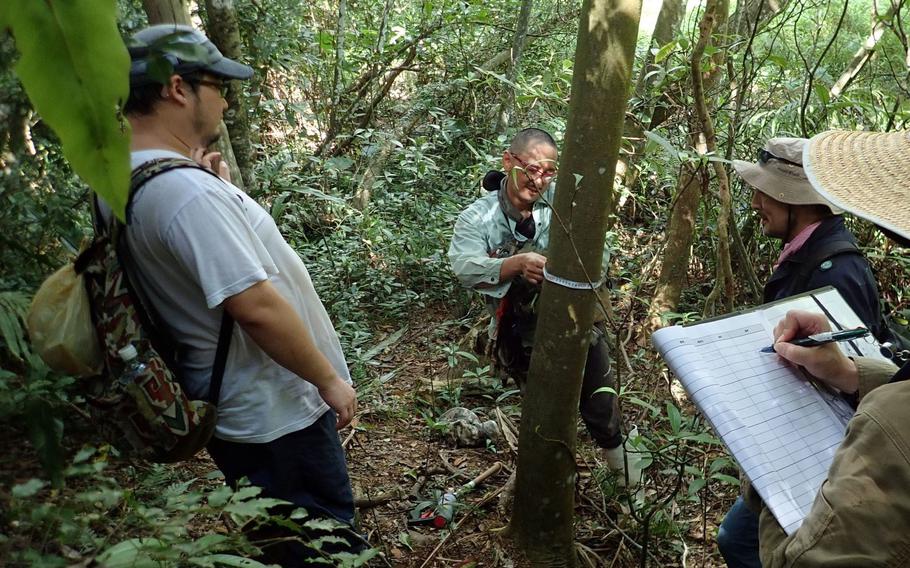
Researchers discovered a historic Ryukyu Kingdom-era forest in August 2022 inside the Kadena Ammunition Storage Area, Okinawa, Japan. (Okinawa Municipal Museum)
A plant survey at a U.S. military construction site on Okinawa discovered a historic forest where timber was harvested during the 450-year era when the island was its own kingdom.
At least some of the trees will be cut down, and the site documented, a spokesman for the Okinawa Defense Bureau, an arm of the Japan Ministry of Defense, told Stars and Stripes by phone Thursday.
The trees were found in August 2022 inside the Kadena Ammunition Storage Area, a 10 square-mile area northeast of Kadena Air Base that lies within two cities, two villages and a township.

Researchers discovered a historic Ryukyu Kingdom-era forest in August 2022 inside the Kadena Ammunition Storage Area, Okinawa, Japan. (Okinawa Municipal Museum)
U.S. and Japan governments agreed in April 2013 to relocate some Defense Department support facilities from the Marine Corps’ Camp Kinser and elsewhere to the Chibana area of the storage area as part of plan to consolidate some U.S. facilities on the island, according to the Defense Ministry website.
The vegetation survey in 2022 and 2023 was part of a wider survey of cultural assets prior to construction starting, Takeshi Kuba, director of the Okinawa Municipal Museum told Stars and Stripes by email Friday.
“We wandered through the forest to identify the various species present. We documented the location and species of all the large trees,” he said.
The survey yielded surprising results, Kuba said.
“We found unique species of trees that cannot be found in other places; then we thought that it might be a somayama,” he said. “Somayama refers to forests that were established and administered by the Ryukyu Kingdom following a wood shortage caused by the burning of Shuri Castle in 1709, with the intention of creating a sustainable source of wood.”
The Ryukyu Kingdom lasted from 1469 to 1879. It became part of Japan under the shogunate in 1609 although it retained its own royal system and relations with China. Under the kingdom, the prefecture developed its own distinctive arts, crafts and culture.
The somayama timber was mainly used to build houses, Kuba said.
The last vestiges of an Okinawa somayama were believed lost during the Battle of Okinawa from March to September 1945 and development that followed, Kuba said. But the survey discovered a healthy example of the historic forest.
“More than 3,000 large trees and 362 species of plants were found at the area, some were hundreds of years old,” Kuba said. “We also found two Japanese yews that were 45-centimeters thick, we think that these were not able to be preserved if people did not administer them for generations.”
Japanese yew, an ornamental evergreen tree native to Japan, Korea and northeast China, was also used as a material to build Shuri Castle. The discovery of two on Okinawa was a bonus, a forestry expert said.
“If that place is a somayama, most of the records about somayamas in central Okinawa are about Ryukyu pines. As far as I know there are no records about Japanese yews; that is valuable,” Kazuhiko Saito of the Forestry and Forest Products Research Institute told Stars and Stripes by email June 21.
The city in August 2022 asked the defense bureau to consider preserving 20 acres of the site, Kuba said.
The bureau decided instead to simply document the site and take down the trees as necessary, the bureau spokesman said Thursday. Some government officials in Japan may speak to the media only on condition of anonymity.
The 18th Wing at Kadena Air Base by email June 20 referred questions from Stars and Stripes to the Okinawa Defense Bureau. “It is a very valuable cultural asset. We think it is important to preserve the area to be able to research how the mountains have been used not only since the Ryukyu kingdom-era but also after World War II,” Kuba said.